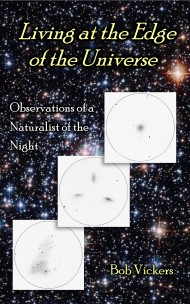On 28 April 2016, I observed GG&C Trio #17, a string of three well spaced galaxies, two bright and one dim. All three fit into the 21.3 minute field of view of my 9mm Televue Nagler. Both N2856 and N2854 were direct vision galaxies, both very elongated and becoming brighter toward the center. Neither had a stellar nucleus. N2857 was more difficult but was visible with averted vision as a roundish glow with very low surface brightness.

GG&C Trio #17–Copyright (c) 2016 Robert D. Vickers, Jr.
Next was Hickson compact galaxy group #60 on 6 June 2016. This is a difficult group and I could only see the “a” and “d” components which I could not separate. They appeared as a single fuzzy elongated patch with averted vision.

GG&C Hickson #60–Copyright (c) 2016 Robert D. Vickers, Jr.
GG&C Additional Galaxy Group #23 (aka NGC 4065 group) is a rich field of several bright galaxies, four of which are direct vision. I observed it on 7 June 2016. N4065, N4061, N4066, and N4070 are all small, roundish, direct vision galaxies with either a stellar nucleus or bright core. N4076, N4072, N4074, N4086, N4060, and N4090 are all dimmer elongated galaxies visible at some level of averted vision.

GG&C Additional #23–Copyright (c) 2016 Robert D. Vickers, Jr.
Next, on 29 June 2016, I observed GG&C Trio #37, a nice string of three bright galaxies, two spiral and one elliptical. All three are direct vision and all three fit nicely into the 9mm Nagler field of view. I had visited this trio before in August 2004 while observing the Herschel 400 (one of which is N5982).

GG&C Trio #37–Copyright (c) 2016 Robert D. Vickers, Jr.
GG&C Abell #39 (Abell 2152) is another difficult cluster. I observed it on 4 September 2016 on a night of marginal transparency. Only two galaxies were visible that night: MCG +3-41-95 and CGCG 108-142. Both are small and round with even brightness and range from very dim to extremely dim. I will need to try this cluster again under better conditions.

GG&C Abell #39 (Abell 2152)–Copyright (c) 2016 Robert D. Vickers, Jr.
3 October 2016 brought another Abell cluster (GG&C #43, aka Abell 2247). Using averted vision, I could only see two galaxies in this large but faint cluster: PGC 59174 and MCG +14-8-18. Both are members of a chain of galaxies called Shakhbazian 166. The former a small, faint, roundish galaxy with no discernable stellar nucleus and the latter not much more than a stellar nucleus in a very small halo.

GG&C Abell #43 (Abell 2247)–Copyright (c) 2016 Robert D. Vickers, Jr.
Another large but faint cluster is GG&C Abell #2 (aka Abell 76) which I observed on 5 October 2016. On this night, I could only see 2 of the 42 galaxies listed as cluster members. These were two of the brighter Index Catalog galaxies, IC 1565 and IC 1566. Both are small and round, becoming brighter toward the center with quasi-stellar nuclei.

GG&C Abell #2 (Abell 76)–Copyright (c) 2016 Robert D. Vickers, Jr.
GG&C Trio #2 is an interesting trio consisting of a larger edge-on galaxy (N12 elongated north/south with two very small, round, and dim “satellite” galaxies (N127 & N130) just to the west and east. When I observed this trio on 29 October 2016, I was also able to see two additional nearby galaxies (N125 and N126), making a quintet!
elongated north/south with two very small, round, and dim “satellite” galaxies (N127 & N130) just to the west and east. When I observed this trio on 29 October 2016, I was also able to see two additional nearby galaxies (N125 and N126), making a quintet!

GG&C Trio #2–Copyright (c) 2016 Robert D. Vickers, Jr.
Later that same night I bagged another trio (GG&C Trio #3) of three small galaxies (N138, N141, and N139), ranging from fairly bright to very dim.

GG&C Trio #3–Copyright (c) 2016 Robert D. Vickers, Jr.

